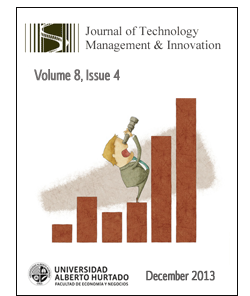Supply Networks and Value Creation in High Innovation and Strong Network Externalities Industry
DOI:
https://doi.org/10.4067/S0718-27242013000500016Keywords:
Videogame, Network externalities, Supply Networks, RBV, Relational View, Disruptive TechnologyAbstract
The rapid developing product and service markets and developments in information technologies have accelerated growth in outsourcing of peripheral activities and critical business as well, enhancing the importance of network supply chain management. This paper analyzes the dynamics of supply chain management and the creation of value in an industry with strong network effects and constantly introduction of disruptive technologies, the videogame industry. This industry evolves at a high velocity, with a lifecycle of five to six years for consoles, which features a new generation of consoles, where new companies and technologies appear and disappear at each generation.Downloads
References
ASAKURA, R (2000). Revolutionaries at Sony: The making of the Sony PlayStation and the visionaries who conquered the world of video games. McGraw-Hill, New York.
BRITO, R.P, Brito, L.L. (2011). Vantagem Competitiva: uma proposta de definição constitutiva e sua relação com desempenho. Paper presented at the proceedings of the XXV encontro ANPAD. Rio de Janeiro -RJ
CHRISTENSEN, C. M. (2000). The Innovator’s Dilemma. HarperCollins, New York.
CHRISTENSEN, C. M. (2002). The rules of innovation. Technology review, 105, 33-38
CORRÊA, H.L., Xavier, L.H., (2013). Concepts, design and implementation of Reverse Logistics Systems for sustainable supply chains in Brazil. Journal of Operations and Supply Chain Management, 6(1), 1–25. DOI: 10.12660/joscmv6n1p1-25
DESHPANDE, R. (2002). Sony Playstation 2. Harvard Business Publishing Case 9-502-016, Harvard Cambridge.
DYER, J.H., Singh, H. (1998). The relational view: Cooperative strategy and sources of interorganizational competitive advantage. Academy of management review, 23(4), 660-679. DOI: 10.2307/259056
EISENMANN, T., Parker, G., and Van Alstyne, M. W. (2006). Strategies for two-sided markets. Harvard Business Review, 84(10), 92-101.
FARRELL, J.; Saloner, G. 1986. Installed base and compatibility – innovation, product preannouncements, and predation. American Economic Review, 76(5), 940-955.
FINE, C.H., (1998) Clockspeed: Winning industry control in the age of temporary advantage. Perseus Books, Massachusetts.
FINE, C. H. (2000) Clockspeed based strategies for Supply Chain Design, Production and Operations Management, 9(3), 213-221 .
GALLAUGHER, J. M., WANG, Y. M. (2002). Understanding network effects in software markets: Evidence from Web server pricing. MIS Quarterly, 26(4), 303-327. DOI: 10.2307/4132311
GRECO, J., Appleyard, M. (2001) Microsoft’s XBox gamble. Tuck School of Business case study 06-0011. Dartmouth.
GUTH, R.A.(2005) Getting Xbox 360 to Market. The Wall Street Journal. http://online.wsj.com/news/articles/SB113227316117900733 [Accessed December 04, 2013]
HOLWEG, M., Pil, F.K. (2008). Theoretical perspectives on the coordination of supply chains. Journal of operations management, 26, 389-406. DOI: 10.1016/j.jom.2007.08.003
KAUFFMAN, R. J., McAndrews, J., Wang, Y. M. (2000). Opening the "black box" of network externalities in network adoption. Information Systems Research, 11(1), 61-82. DOI: 10.1287/isre.11.1.61.11783
KATZ, M. L., Shapiro, C. (1985). Network externalities, competition, and compatibility. American Economic Review, 75(3), 424-440.
LEE, H; Hoyt, D; Holloway, C. (2006). Evolution of the Xbox Supply Chain. Stanford Graduate School of Business case GS-49. Stanford University, Stanford.
MADHOK, A; Tallman, S.,B.(1998) Resources, transactions and Rents: Managing value through interfirm collaborative relationships. Organization Science, 9(3), 326-339. DOI: 10.1287/orsc.9.3.326
McIVOR, R. (2009). How the transaction cost and resource-based theories of the firm inform outsourcing evaluation. Journal of Operations management, 27(1), 45-63. DOI: 10.1016/j.jom.2008.03.004
NAYAK, M.F. (2013). A look at the $66 billion video-games industry. http://in.reuters.com/article/2013/06/10/gameshow-e-idINDEE9590DW20130610 [Acessed September 7, 2013]
OFEK, E. (2005). Home Video games: Generation Seven. Harvard Business Publishing case 9-505-072, Harvard Cambridge.
PERRONS, R.K., Richards, M.G., Platts, K. (2004). The effect of industry clockspeed on make-or-buy decisions in the face of radical innovations: an empirical test. International Journal of Innovation Management, 8(4), 431-454.
SHAPIRO, C., Varian, H. R (1998). Information Rules: A Strategic Guide to the Network Economy. Harvard Business School Press. Boston.
SHERIF,K., Zmud, R. W., Browne, G. J.(2006). Managing peer-to-peer conflicts in disruptive information technology innovations: the case of software reuse. MIS quarterly, 30(2), 339-356.
SLEDGIANOWSKI, D., Kulviwat, S. (2009). Using social network sites: The effects of playfulness critical mass and trust in a hedonic context. Journal of Computer Information Systems, 49(4), 74-83.
TAKAHASHI, D. (2002). Opening the Xbox. Prima publishing, Roseville.
TAKAHASHI, D. (2006). The Xbox 360 Uncloaked. Lulu Press.
YIN, R. (2013) Case Study Research: Design and Method. 5th edition, Sage. Thousand Oaks.
ZEN, A. C.; Dalmoro, M.; Fensterseifer, J.E.; Wegner, D. (2013). O desenvolvimento de recursos em redes interorganizacionais e o processo de internacionalização: O Caso Wines of Brasil. Revista Ibero-Americana de estratégia –RIAE, , 12(1), 107-130.
Downloads
Published
How to Cite
Issue
Section
License
Copyright (c) 2013 Journal of Technology Management & Innovation

This work is licensed under a Creative Commons Attribution-ShareAlike 4.0 International License.







